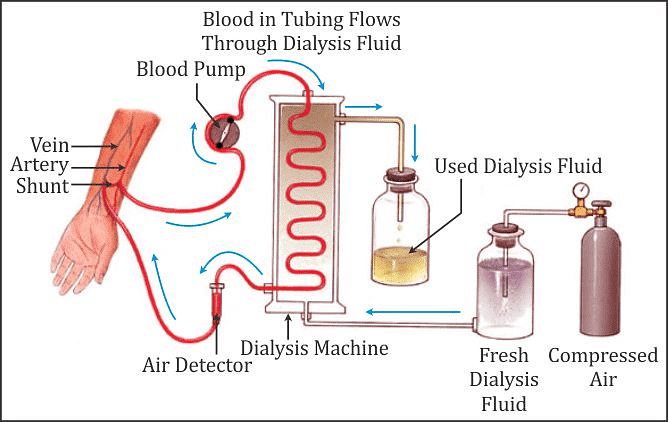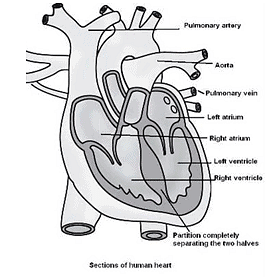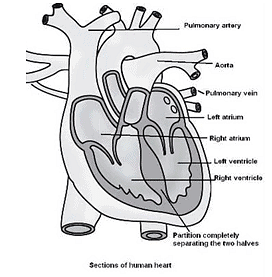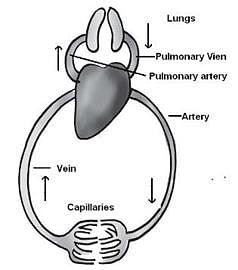Class 7 Science Chapter 7 Question Answers - Transportation in Animals and Plants
Short Q & A :
Q1: What do you mean by dialysis? Explain.
Ans : Dialysis is an artificial process of getting rid of waste and unwanted water from the blood by dialysis machines. Dialysis machines contain a tank with solution of water glucose and salt. Patient’s blood allowed passing through solution for removal of waste. The cleaned blood pumped to vein. The dialysis continues till all blood has been purified.
 Dialysis
Dialysis
Q2: Write the two functions of kidneys.
Ans : The two functions of kidney are excretion and osmoregulation. Excretion is the elimination of metabolic waste products from the body. Osmoregulation is regulating osmotic pressure of the body fluids by controlling the amount of water and salts in the body.
Q3: State one function of the following:
- Arteries
- Vein
- Capillaries
Ans : Arteries- carry blood from heart to different parts of body
Veins-carry blood from different parts of body to the heart.
Capillaries-exchange of material between blood and surrounding cells.
Q4: Why is heart known as the pumping organ of the human body?
Ans : Heart is the pumping organs of a human body as it continuously act as a pump for transporting blood to all body parts. Heart pumps carbon-dioxide rich blood to lungs and oxygen rich blood to rest of the body.
Q5: What is the significance of dividing heart into different chambers?
Ans : The division of heart into different chambers ensures that there is no intermixing of oxygenated and deoxygenated blood. This ensures a better efficiency of circulation and transportation of oxygen.
Q6: Explain pulse and pulse rate.
Ans : When blood flows in arteries, it gives throbbing sensation in arteries. This throbbing sensation is known as a pulse. The rate of heart beat or throbbing is known as pulse rate. A person has a pulse rate between 72 to 80 beats per minute. A stethoscope is an instrument used to measure the sound heartbeat.
Q7: Why walls of veins are thinner than the walls of arteries?
Ans : Veins do not have thick walls because blood in vein is no longer under pressure but blood emerges from the heart is under high pressure. So arteries have thick walls.
Q8: How do plants absorb water and minerals from soil?
Ans : Plants absorb water and minerals from soil by the roots. The root hair absorbs water and dissolved mineral nutrients from the soil. The roots remain in contact with underground water.
Q9: Differentiate between arteries and veins.
Ans :
Arteries | Veins |
|
|
Q10: Differentiate between atrium and Ventricle.
Ans :
Atrium | Ventricle |
|
|
Q11: Why do sponges and hydra not have blood?
Ans : Animals such as sponges and hydra do not possess any circulatory system. The water in which they live brings food and oxygen as it enter their body the water carries away waste materials and carbon dioxide as it moves out.
Q12: Enlist the functions of blood.
Ans :
- It transports substances like digested food from the small intestine to the other parts.
- It carries oxygen and carbon dioxide to their respective organs and tissues
- It transports wastes for removal from the body.
Q13: Differentiate between xylem and phloem.
Ans :
Xylem | Phloem |
|
|
Q14: Differentiate between RBC and WBC.
Ans :
RBC | WBC |
|
|
Q15: Why is blood needed by all the parts of the body?
Ans : The blood is needed by all parts of the body because it transports substances like digested food from the small intestine to the other parts of the body. It carries oxygen from the lungs to the cells of the body. It also transports waste for removal from the body.
Q16: Why blood is red in colour?
Ans : The presence of haemoglobin makes blood appear red. Haemoglobin bind with oxygen and transports it to all the parts of the body and ultimately to all the cells. It will be difficult to provide oxygen efficiently to all the cells of the body without haemoglobin.
Q17: What is the function of RBCs?
Ans : Red Blood Cells (RBCs) contain a red pigment called haemoglobin. Haemoglobin bind with oxygen and transports it to all the parts of the body and ultimately to all the cells. It will be difficult to provide oxygen efficiently to all the cells of the body without haemoglobin. The presence of haemoglobin makes blood appear red.
Q18: Does transpiration serve any useful function in the plants? Explain.
Ans : Plants absorb mineral nutrients and water from the soil. Not all the water absorbed is utilised by the plant. The water evaporates through the stomata present on the surface of the leaves by the process of transpiration. The evaporation of water from leaves generates a suction pull which can pull water to great heights in the tall trees. Transpiration also cools the plant.
Q19: Explain stomata and its function in plants.
Ans : Stomata are tiny pores present on the surface of the leaves. These pores are surrounded by ‘guard cells’. Following are its function in plants:
- The carbon dioxide required in the process of photosynthesis is made available by Stomata, through direct absorption from the air.
- Stomata help Plants in absorption of mineral nutrients and water from the soil. Not all the water absorbed is utilised by the plant. The water evaporates through the stomata present on the surface of the leaves by the process of transpiration. The evaporation of water from leaves generates a suction pull which can pull water to great heights in the tall trees. Transpiration also cools the plant.
Q20: What will happen if there are no platelets in the blood?
Ans : The platelets are another type of cells in blood, which are responsible for formation of clot in blood when it comes in contact with air. So this prevents excess bleeding from the injury as it plugs the skin opening by clout formation on it. If there are no platelets in the blood, then we may die from a small injury due to excess blooding as there will be no clotting to plug it.
Q21: What is the significance of transport of materials in plants and animals?
Ans : Transport of materials is very important in plant or in animals as all organisms need food, nutrition, water and oxygen for survival. The food is the source of energy and every cell of an organism gets energy by the breakdown of glucose. The cells use this energy to carry out vital activities of life. Therefore food must be made available to every cell of an organism. They need to transport all these to various parts of their body. Further, animals need to transport wastes to parts from where they can be removed.
Q22: Why is it necessary to excrete waste products?
Ans : When our cells perform their functions, certain waste products are released. These waste products are toxic and hence need to be removed from the body. The process of removal of wastes produced in the cells of the living organisms is called excretion.
Q23: Draw a labelled diagram of the human excretory system.
Ans :

Q24: Draw a labelled diagram of the human heart.
Ans :

Q25: Briefly describes the human circulatory system?
Ans : The circulatory system is made up of the Blood vessels, heart and Blood that help and control the flow of the blood around the body. Heart pumps blood around your body by alternate systole and diastole. Blood is the connective tissue that carries food, air, waste product and hormones. it contain fluid medium called plasma and three types of cell RBC, WBC and Platelets. There are three distinct types of blood vessels, namely, arteries, veins and capillaries circulate blood around body.
Q26: Explain form and function of urinary system in man?
Ans : The circulatory system is made up of the Blood vessels, heart and Blood that help and control the flow of the blood around the body. Heart pumps blood around your body by alternate systole and diastole. Blood is the connective tissue that carries food, air, waste product and hormones. it contain fluid medium called plasma and three types of cell RBC, WBC and Platelets. There are three distinct types of blood vessels, namely, arteries, veins and capillaries circulate blood around body.
Q27: What is heartbeat? Name the instrument used to provide information about heartbeat.
Ans : One complete contraction and relaxation of heart makes one heartbeat. Electrocardiogram (ECG) is used to check the rhythm of heartbeat.
Q28: Sometimes doctor inject medicines directly in our bloodstream, where do they inject in artery or in vein?
Ans : doctor inject medicines in vein because veins are superficial and are easily locatable, secondly medicines need to be transported to all parts of the body through vein medicines reaches heart and from heart it is pumped to all part of body.
Q29: Explain the role of platelets in blood clotting.
Ans : The platelets are responsible for formation of clot in blood when it comes in contact with air. So this prevents excess bleeding from the injury as it plugs the skin opening by clout formation on it. If there are no platelets in the blood, then we may die from a small injury due to excess bleeding as there will be no clotting to plug it.
Q30: Describe the functioning of excretory system.
Ans : The cells in the body perform various activities. Waste products such as urea, uric acid and excess water are formed and have to be removed from the body. The removal of waste products is termed excretion. The organs that help in the process of excretion constitute the excretory system, and include the kidneys, the ureters, the urinary bladder and the urethra. The useful and harmful substances in blood enter the kidneys, where the capillaries filter it. The useful substances are reabsorbed, but the harmful substances are removed along with water in the form of urine. The urine from the kidneys comes down through long tubes called the ureters, which open into the urinary bladder where the urine is stored temporarily. When the bladder fills, the urine is disposed.
Long Q & A :
Q1: Describe the function of the heart and circulatory system.
Ans : The heart is an organ which beats continuously to act as a pump for the transport of blood, which carries other substances with it. The heart is located in the chest cavity with its lower tip slightly tilted towards the Left. Heart is roughly the size of a fist. To avoid mixing up of blood rich in oxygen with the blood rich in carbon dioxide, the heart has four chambers. The two upper chambers are called the atria (singular: atrium) and the two lower chambers are called the ventricles The partition between the chambers helps to avoid mixing up of blood rich in oxygen with the blood rich in carbon dioxide.To understand the functioning of the circulatory system, start from the right side of the heart as show in the in Fig and follow the arrows. These arrows show the direction of the blood flow from the heart to the lungs and back to the heart from where it is pumped to the rest of the body.

The walls of the chambers of the heart are made up of muscles. These muscles contract and relax rhythmically. This rhythmic contraction followed by its relaxation constitutes a heartbeat. The rhythmic beating the various chambers of the heart maintain circulation of blood and transport of substances to the different parts of the body.

Schematic diagram of circulation
The cells in the body perform various activities. Waste products such as urea, uric acid and excess water are formed and have to be removed from the body. The removal of waste products is termed excretion. The organs that help in the process of excretion constitute the excretory system, and include the kidneys, the ureters, the urinary bladder and the urethra. The useful and harmful substances in blood enter the kidneys, where the capillaries filter it. The useful substances are reabsorbed, but the harmful substances are removed along with water in the form of urine. The urine from the kidneys comes down through long tubes called the ureters, which open into the urinary bladder where the urine is stored temporarily. When the bladder fills, the urine is disposed.
Q2: Explain the function and components of blood.
Ans : The main components of bloods are :
- Plasma: The fluid part of the blood is called plasma.
- Red Blood Cells (RBC) contains a red pigment called haemoglobin. Haemoglobin bind with oxygen and transports it to all the parts of the body and ultimately to all the cells. It will be difficult to provide oxygen efficiently to all the cells of the body without haemoglobin. The presence of haemoglobin makes blood appear red.
- White Blood cells (WBC) fight against germs that may enter our body thus provide an effective defence against infection, disease etc.
- Platelets: They are another type of cells in blood, responsible for the formation of dark red clot in the blood when it comes in contact with air. They help in preventing excess bleeding from the injuries by plugging the skin openings or cuts with a thick dark red clot
- It transports substances like digested food from the small intestine to the other parts.
- It carries oxygen and carbon dioxide to their respective organs and tissues
- It transports wastes for removal from the body.
|
111 videos|246 docs|28 tests
|
FAQs on Class 7 Science Chapter 7 Question Answers - Transportation in Animals and Plants
| 1. How do animals transport oxygen and nutrients throughout their bodies? |  |
| 2. How do plants transport water and nutrients from the roots to the leaves? |  |
| 3. What is the role of stomata in the transportation of gases in plants? |  |
| 4. How do animals and plants regulate their transportation systems? |  |
| 5. How does the transportation system in animals and plants contribute to their overall survival and functioning? |  |

|
Explore Courses for Class 7 exam
|

|













